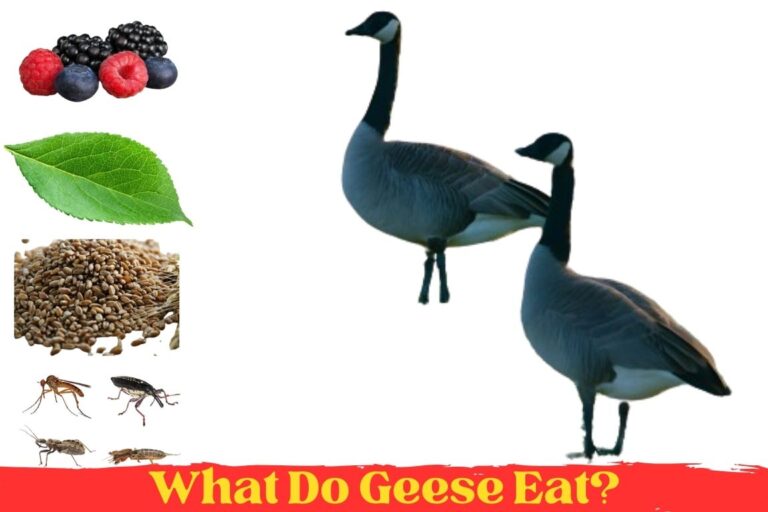Peacock Colors: 14 Colors | 3 Species | 5 Body Patterns
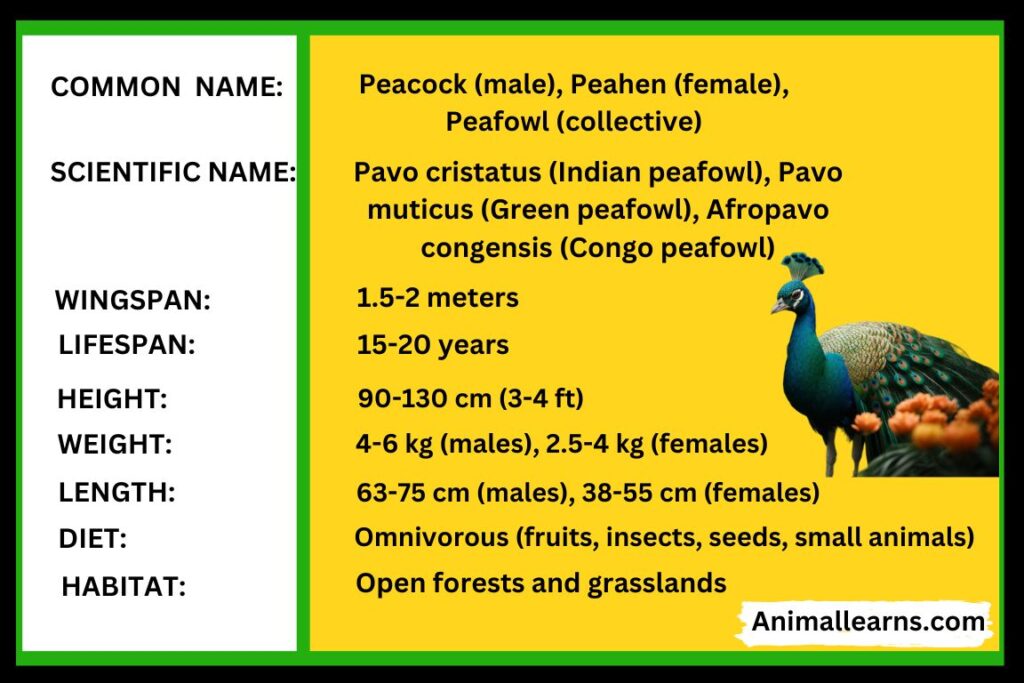
Peacock colors, with their iridescent blues and shimmering greens, are a mesmerizing display of nature’s artistry. Peacocks are huge, colorful birds with unique sounds that can be heard far away.
They are well-known for their captivating beauty. In common parlance, “peahens” refers to female birds, whereas “peacock” refers to both male and female birds.
When roosting in woodlands, wild peafowl frequently congregate in flocks. Peacocks are omnivores by nature, meaning they eat a wide range of things, such as plants, berries, and grains. For thousands of years, people have kept blue peacocks as pets because of their exquisite beauty.
Their vibrant hues give houses an air of charm. The blue peacock, which is found in India and Sri Lanka, and the green peacock, which is found in Burma and Indonesia, are two well-known species. The African rainforest is home to the Congo peacock, another lesser-known species.
Peafowls are big, vibrant birds that are well-known for the intricate courtship rituals that male peacocks perform. This page examines the whole peafowl taxonomic range, including several species, color variations, body patterns, and the global variety of peafowls.
Iridescent tones ranging from vibrant blues and lush greens to glittering teals and deep turquoise make up the visual marvel of peacock hues.
These feathers have inspired artists, designers, and the fashion industry in addition to enthralling ornithologists and wildlife enthusiasts.
Peacocks are emblematic of Indian monarchy and the Hindu faith, and they originated in Asia. These birds are loved all around the world for their beautiful blue and green tail feathers, which continue to blur the boundaries between the natural and creative realms, despite their high-pitched cries.
Common and Rare Peacock Colors
Contents
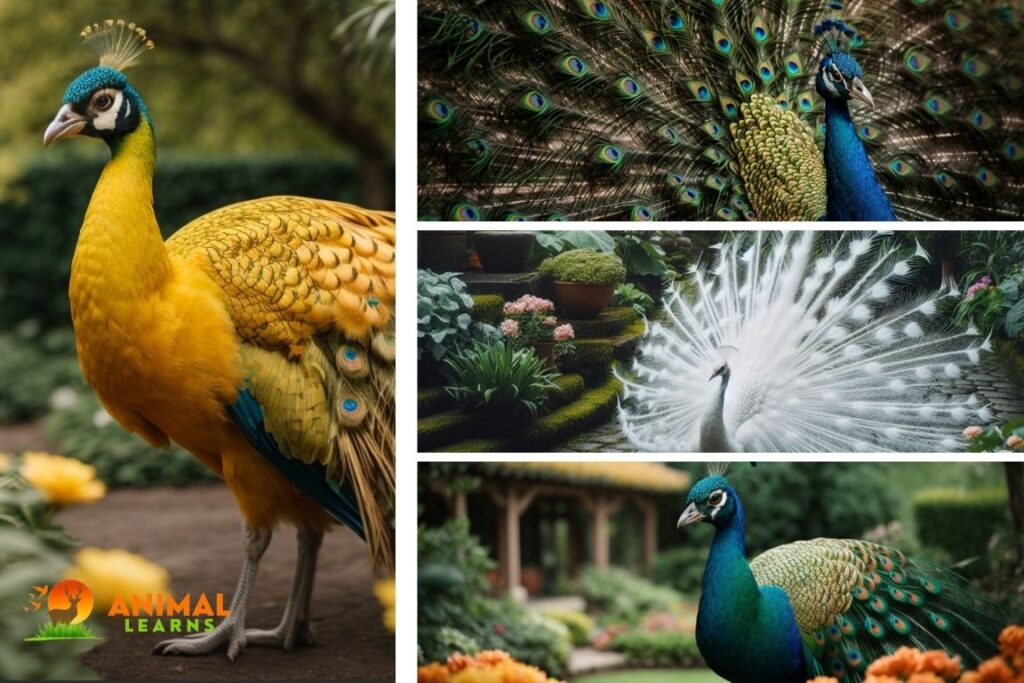
The colors of the peacock are the main source of its beauty and allure. Peacocks come in various striking hues, but the shape of their neck mostly determines their color.
Although there are over 14 different hues of peacocks, blue peacocks are the most common ones that we observe.
Peacock colors are quite uncommon, except blue. We frequently get to see them because they are typically kept as pets.
As far as we are aware, peacock colors are either blue or green; nevertheless, a genetic mutation can produce a variety of peacock colors.
In addition to the green and blue peacock colors, there are 14 more variations of peacocks due to a transformation in the bird’s inherited cosmetics that affect the hues of the colors. The 14 peacock colors that aren’t blue and green are listed below.
| Color | Description |
| Blue | The most prevalent peacock color is an iridescent blue that is caused by light interfering with the structure of the feathers. |
| Green | Found in green peafowl, the nutrition of the bird affects its hue |
| Purple | An unusual purple hue that is exclusive to Indian peafowls and is brought on by a mutation in the melanin gene. |
| Turquoise | A hybrid of the Indian and green peafowl, having turquoise plumage speckled with blue and black. |
| Gray | Rare color in Indian peafowl, caused by a lack of melanin, resulting in gray feathers. |
| White | White peacocks are not albino; rather, they are leucistic, lacking pigment, and their feather color is influenced by a hereditary disease. |
| Opal | This variety has an iridescent shine to the feathers. |
| Jade | Jade is a remarkable peacock color variant with a greenish-blue tint. |
| Taupe | Taupe peacocks exhibit a brown color variation. |
| Midnight | This variation boasts very dark blue plumage. |
| Charcoal | Charcoal peacocks feature a very dark gray color. |
| Buford Bronze | Exhibiting a bronze-colored sheen, Buford Bronze is a unique peacock color variation. |
| Peach | A light pink color characterizes Peach peacocks. |
| Sonja’s Violeta | This color variation has a lavender color. |
Common Peacock Colors
Blue, green, brown, and yellow are the 4 colors most commonly associated with peacocks.
- Blue: Blue is the traditional peacock color and is most frequently connected to the Indian peafowl. Because light interferes with the feathers’ tiny structure, giving them an iridescent shine, the feathers seem blue.
- Green: The term “green peafowl” refers to its characteristic green plumage, which frequently has accents of bronze or gold. Their feathers’ structural coloring and melanin combine to give them their green hue.
- Brown: Several peacocks with copper-colored bodies have brown tails and other body parts. The Buford bronze species features chocolate brown tails with black brown eye patches.
- Yellow: Regarding the common hue of yellow peacocks, we can observe this color peacock only in all or a portion of the barbule; in actuality, yellow peacocks do not exist.
Rare Colors of Peacock
The hues white, red, purple, peach, jade, opal and pink are the rarest peacock colors that we have found. While the majority of peacocks’ feathers are blue and green.
Peacocks look amazing in white, and the fact that we don’t often see them in white, red, purple, or pink is another reason why these hues are so striking.
Some of these colors are only found in pictures and tales. The majority of individuals raise green and blue-colored peafowl. Female leucism species are yellow at birth, but they eventually turn white as they age.
A subset of peacocks are albinos; their bodies are white from a lack of melanin or pigment, and their pupils are pink or red.
Peacock Species
Let’s start by defining the phrases peafowl, peacock, and peahen since some people use them erroneously. The male bird, the peacock, and the female bird, the peahen.
The popular term for both male and female birds is peafowl. Peachicks are baby peafowls, and it can be challenging to determine the gender of these birds.
The Indian Peafowl, Green Peafowl, and Congo Peafowl are the three species of peafowl that have been identified.
All three kinds of peacocks are showy birds, both the males and the females. However, even within the same species, peahens and peacocks have distinct features.
Indian Peacock (Pavo cristatus)
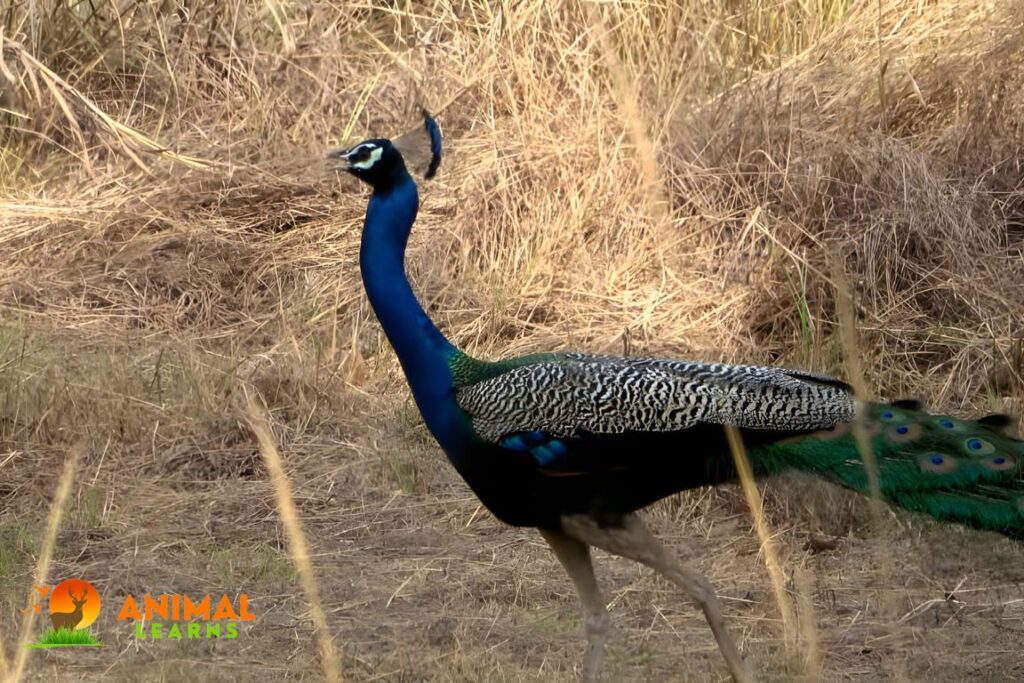
| Feature | Description |
| Scientific Name | Pavo cristatus |
| Lifespan | 20-25 years |
| Diet | Omnivorous (fruits, insects, small animals) |
| Habitat | Forests, grasslands, cultivated lands |
| Origin | Indian subcontinent |
| Wingspan | 5-6 feet |
| Weight | 8-13 pounds |
Indian peacocks are sometimes referred to as blue peacocks because of the blue color of their head, body, and tail, which has a blue-green hue. Among its many remarkable physical features is the long top tail of the Indian peacock.
They also have skulls that are curled and short. Peahens, the female kind, are distinct from peacocks. Their breasts are dark brown with a bright green tint, and they have brown bodies and tails, despite having blue heads like peacocks.
Although blue peacocks are indigenous to India and Sri Lanka, they are now widespread across East Asia.
Green Peacock (Pavo muticus)
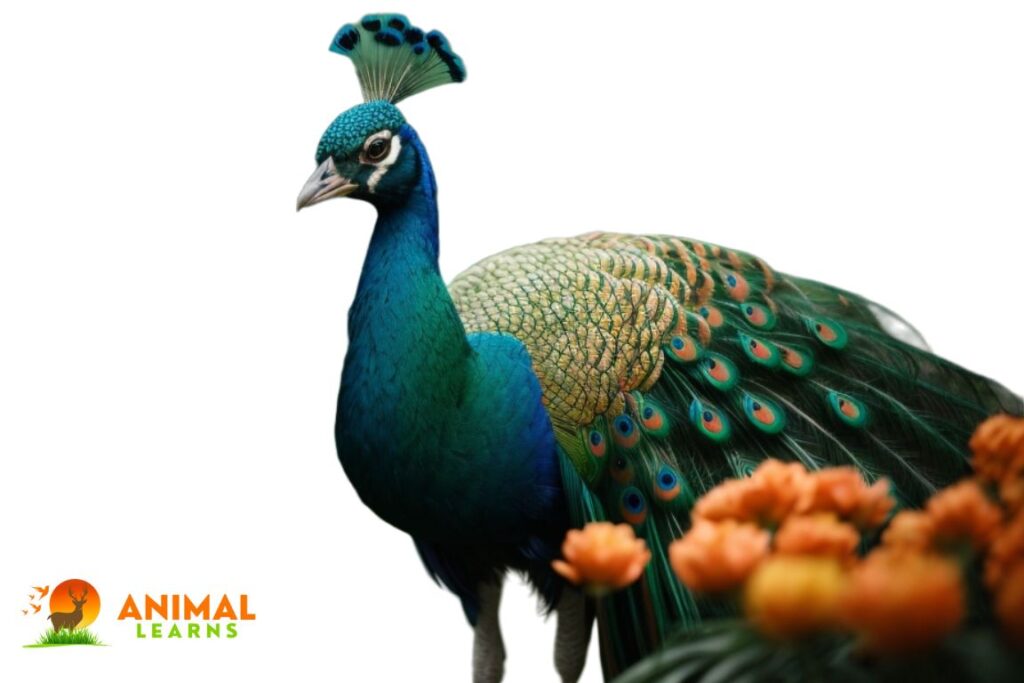
| Feature | Description |
| Scientific Name | Pavo muticus |
| Habitat | Southeast Asia, including Java, Myanmar, Thailand, Vietnam, Laos |
| Diet | Omnivore, including fruits, seeds, insects, and small animals |
| Lifespan | 20-30 years |
| Length | 100-115 cm |
| Weight | 5-6 kg |
| Wingspan | 150-200 cm |
| Plumage | Green with bronze or gold accents |
| Tail Feathers | 150-200 cm long, green with iridescent eyespots |
Javanese peacocks, often called Indonesian peacocks, are another name for green peacocks. They are indigenous to Southeast Asia and have been seen on the Indonesian island of Java. Similar to Congo peafowls, these peacock bird species are extremely uncommon.
Their population declines in recent years are attributed to habitat destruction. Agriculture and deforestation are the main reasons behind the population decline of that species.
In terms of looks, green peahens have short feathers on their necks and green necks, whereas green peacocks have long-shifted crests and dark green heads.
Congo Peacock (Afropavo congensis)
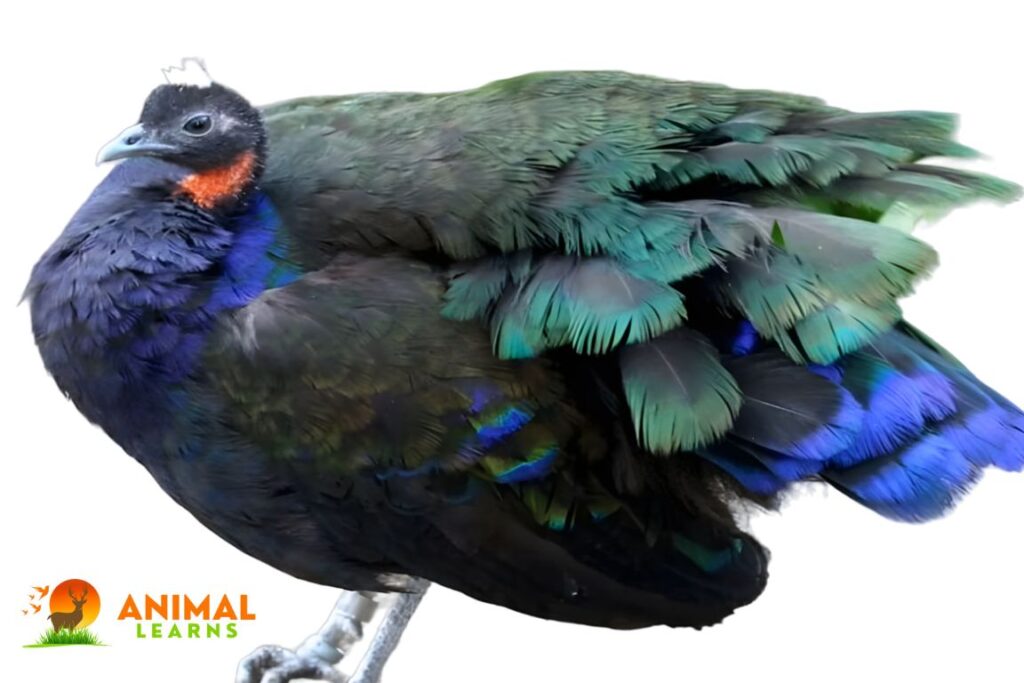
| Feature | Description |
| Scientific Name | Afropavo congensis |
| Common Names | Congo peacock, African peacock, Mbulu (by the Bakongo) |
| Lifespan | 15-20 years |
| Length | 63-75 cm (24.8-29.5 in) |
| Weight | 1.5-2.5 kg (3.3-5.5 lb) |
| Wingspan | 1.5-2 meters (4.9-6.5 ft) |
| Diet | Omnivorous (fruits, insects, seeds) |
| Habitat | Rainforests of Central Africa |
| Conservation Status | Near Threatened |
The Congo Peafowl is not recognized by some academics as a species of peafowl. However, articles referring to them as the third species of peafowls can appear. Thus, it’s listed here as well.
Africa is the natural home of Congo peafowls. On the IUCN Red List, they are likewise regarded as vulnerable. Additionally, some information on these species is accessible. These peafowls are not known to have any subspecies.
The peafowls of the Congo lack the extended trains of their Asian cousins. They become less glamorous as a result. Additionally, the look of the Congo peacock and peahen differs.
Peacock Body Patterns
Patterns are the physical characteristics of peacocks. These birds may exhibit and carry a particular body pattern, but this does not alter the color of their necks, which is used to identify them. A peacock’s body design may be described by the colors of its feathers.
The terms “peacock colors” and “peacock patterns” often refer to two characteristics of peacock birds that differ from one another in behavior. There are two distinct factors associated with peacocks: the colors of their plumage and patterns.
There are five distinct patterns, including, barred wing, black shoulder, pied, silver pied, and white-eyed, that are used to identify different types of peacocks.
Peafowl variants are classified according to 5 distinct peacock designs. Those are
- Barred wing (wild peacock type)
- Black-shoulder
- Pied
- Silver pied
- White-eyed
Barred Wing Peacocks
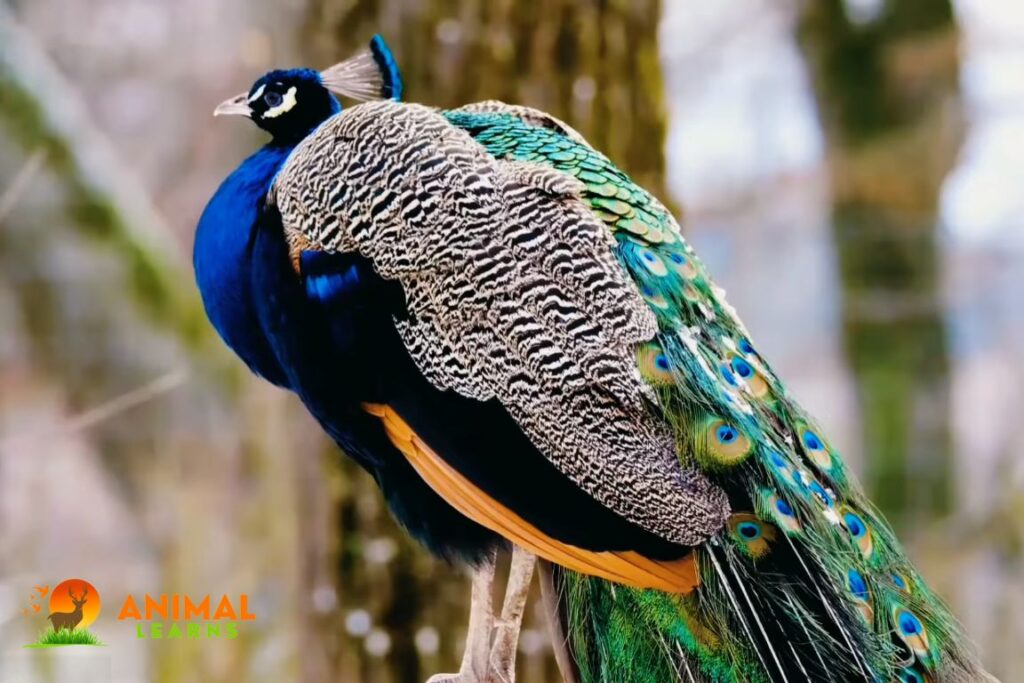
Barred wings are the most prevalent and organic pattern found in peacock birds. It remains conspicuous, especially in Indian blue peacock birds. This design has been constructed with stripes on the wing cover feathers or with a sequence of vertical bars.
Peahens have lighter brown or beige color patterns, whereas peacock birds have black or brown color bars. Because it is metallic green in color, this design is more noticeable and eye-catching than others.
On the other side, this pattern is inconvenient in peahen birds as the feathers’ general brown tone does not seem appealing.
Black Shoulder Peafowls

An Indian peafowl’s pattern mutation gave rise to black-shoulder peacocks. Another name for a peafowl’s wings is shoulders.
The thick black feathers on this bird’s upper back and shoulders are referred to as its “black-shoulder pattern.” Only this pattern is noticeable in male peacocks. The primary distinction between Black-shoulder and Indian Blue peacocks is the simple black wings.
The Indian Blue and Black-shoulder peahens may be easily distinguished from one another. Their body color is white, gray, or pale cream, with sporadic black patches on their wings and body. Their necks become colored cream or reddish.
Pied Peacocks
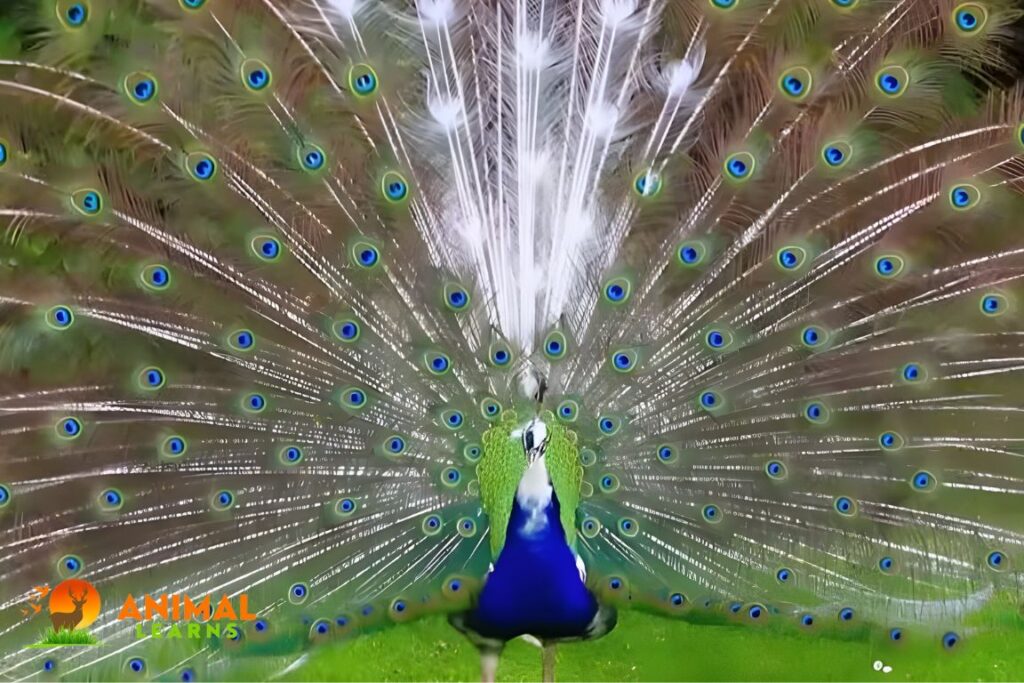
Feathers that are a combination of color and white have a pied pattern that might resemble a bird. The pied pattern mutation results in the lack of pigment in the quills of the bird and eventually causes all peacock and peahen birds’ bodies to have erratic white splotches across them.
These birds are around 40% white and 60% colored. Additionally, pied birds can have a large number of quills blending in with their typical blue and green plumes.
Silver Pied Peacocks
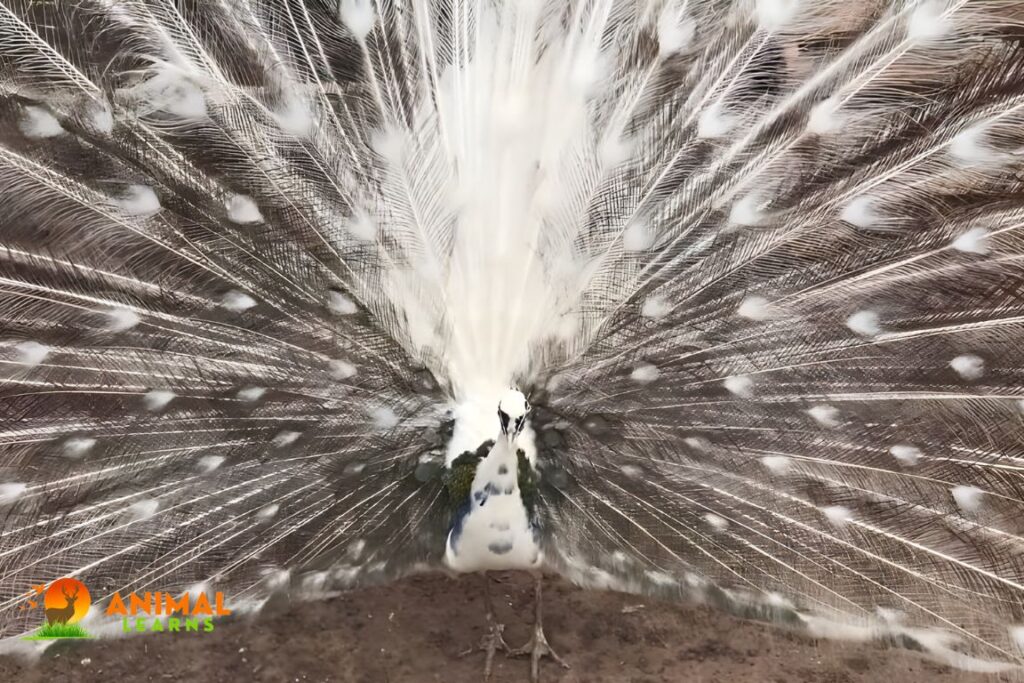
The feathers in the silver pied design have a base color that is either white or light blue. Additionally, their head, neck, and wings are marked in dark blue or black. Of their feathers, only approximately 25% will have typical coloring.
It is determined that this pattern is a recessive feature. It indicates that when a person carries two copies of the trait’s gene, this happens. The bird’s coloring will be normal when there is just one copy of the gene.
White-Eyed Peacocks
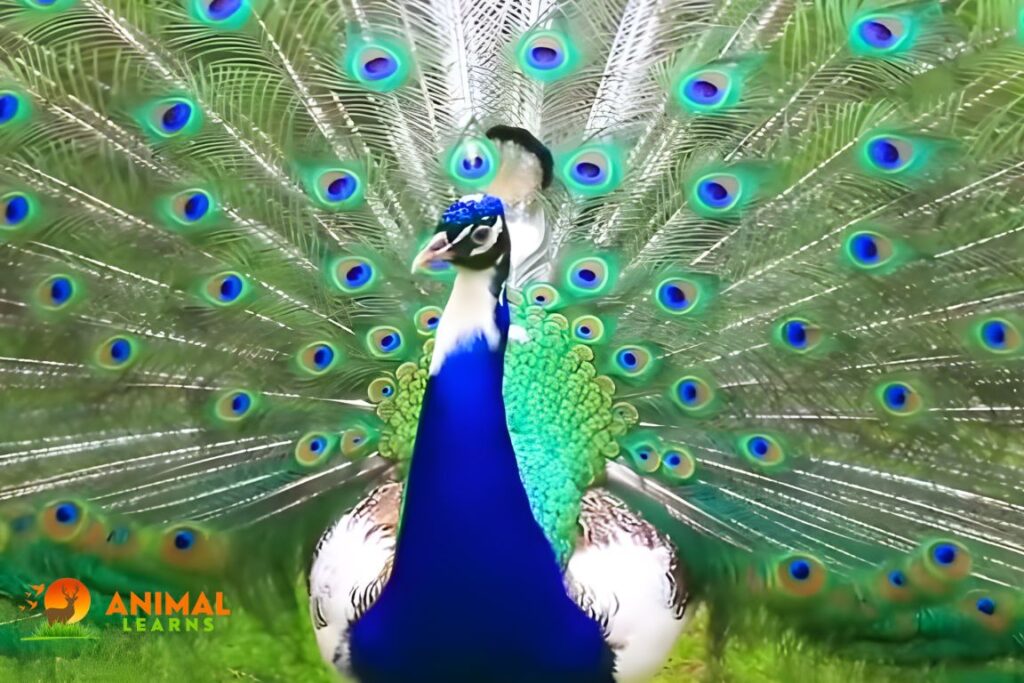
The white-eyed pattern mutation may be the source of the ocellus or eye in peacock birds that are trained to be white. Peahen birds may have a less pronounced white-eyed pattern mutation than peacock birds due to the absence of a train.
Another characteristic of peacocks that gives them a frosted appearance is when one of their feathers turns white. Look for the white that flickers at the tips of the body feathers of peahens to identify the white-eyed gene.
Do Peacocks Change Their Colors
In contrast to chameleons, peacocks do not have color changes. Peafowl are incapable of altering the color of their own feathers. The natural color of a peacock’s feathers is dictated by the structure of the feathers rather than by pigment.
The peacock feathers appear to change color when exposed to light, yet they maintain their original color when touched. Peacocks do not have exquisite, vibrant feathers from birth. With time, their feathers develop. Upon birth, both male and female peafowls have the same appearance.
Their feathers begin to develop at the age of three, and by the time they are six years old, they are the brightest, lustrous, and most colorful.
Male and female peacocks differ in appearance, despite the common misconception that their feathers are nearly identical. The female has dull brown feathers, while the male has vivid green and blue feathers.
Peacock Egg Color
Peacock eggs are either white or light brown in color, and after a month, the offspring hatch out to become yellow. For male peacocks, the age of sexual maturity is two years, while for female peacocks, it is three years. Male peacocks do not practice monogamy as other birds do, therefore each year they give birth to four to seven different ladies.
Hybrid Vs Purebred Peafowls
Peafowls that are purebreds have parents who belong to the same species. For instance, since the offspring of an Indian peacock and an Indian peahen are members of the same species (Indian peafowls), they are said to as purebred.
Peafowls mate within their own species by nature. So, the only peafowls you will encounter in the wild are purebred birds. Nonetheless, in captivity, Indian and Green peafowls are mating to create hybrid peafowls.
The late Mrs. Keith Spalding of California created the first hybrid peafowl by allowing the Indian and Green peafowl species to mate. Thus, hybrid peafowls bearing Mrs. Spalding’s name are referred to as “Spalding.”
How Can I Tell Which Peafowl Varieties Are Hybrids?
Most often, a hybrid peafowl variety may be identified by visual morphological inspection. It is less expensive and quicker than genetic testing.
To tell hybrid peafowls apart from their purebred counterparts, a number of distinguishing characteristics have been identified.
These include their larger legs, mixed temperament, distinct plumage traits, facial color (they have some yellow on their face), crest form, and quicker development rate compared to purebreds.
5 Colorful Peacock Facts

- Although the word “peacock” is sometimes applied to both male and female peafowl, only the males are actually considered to be “peacocks” since only they have the distinctive, vibrant train feathers. The females, referred to as peahens, are duller in color and do not have a train.
- Peacocks do not constantly lose their feathers, despite what the general public believes. Rather, they go through a full molt once a year, often in July and September. They lose all of their feathers at this period, with the exception of the train feathers, which regrow over several months.
- Although they are frequently connected to Asia and India, peacocks are not indigenous to these countries. Originally restricted to the Indian subcontinent, they have now spread to various regions of the world, including Africa, North America, and Europe, after centuries of introduction.
- Peacocks are very skilled climbers for their size and plumage. They maneuver through trees and other tall buildings using their muscular legs and claws, frequently looking for cover from predators or a place to spend the night.
- Throughout history, peacocks have been held in high regard by several societies. In many Asian civilizations, they are seen as representations of beauty, nobility, and good fortune. Peacocks are connected to the Hindu god Krishna and are seen as a representation of the love and protection of the divine.
Differentiating Between Peafowl Male and Female
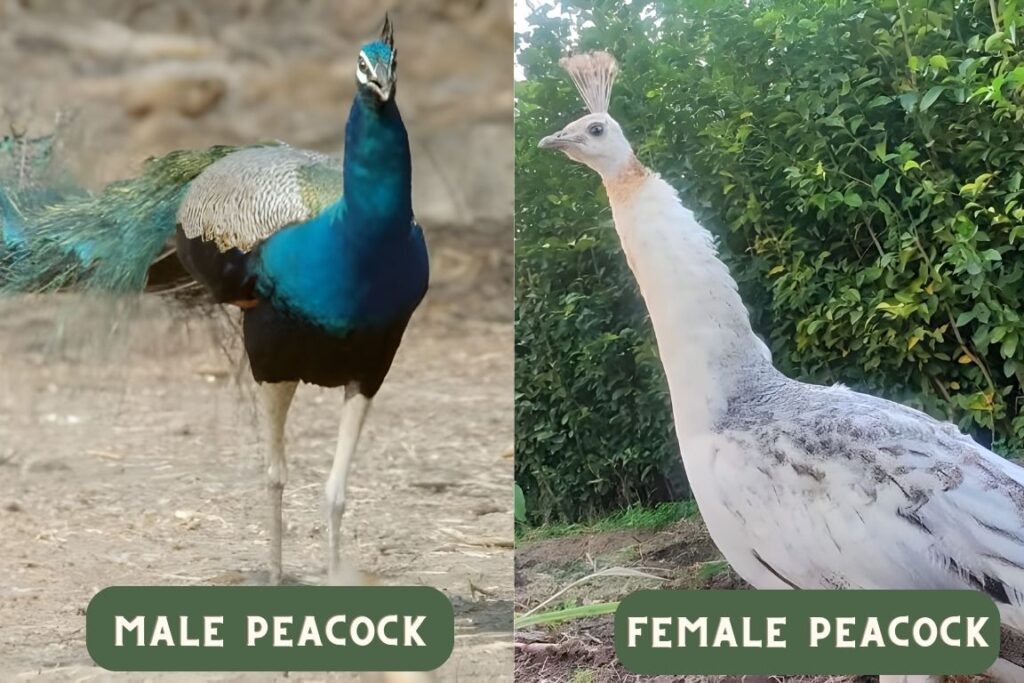
| Feature | Male Peacock | Female Peacock |
| Train Feathers | Large and colorful | Absent |
| Body Size | Larger | Smaller |
| Color | Blue and green | Brown with white markings |
| Crest | Larger and brighter | Smaller and duller |
| Facial Skin | Bare and blue or white | Feathered |
| Behavior | More vocal and showy | Less vocal and showy |
Train feathers
The easiest way to tell is to look for train feathers. Large, vibrant train feathers that may grow up to six feet long are characteristic of male peafowl. The male peacock’s silhouette is dominated by these feathers, which are employed in courting displays.
The train feathers are absent from female peafowl, generally known as peahens, and their brown feathers are considerably duller and shorter.
Size and color of the body
Compared to females, male peacocks tend to be bigger and have brighter colors. Usually, the females have brown feathers with white patterns, and the males have iridescent blue and green plumage.
Crest
The male and female sexes both have crests on their heads, although the male typically has a bigger and more vividly colored crest.
Facial skin
Male peacocks have bare-face skin, which is often white or blue in hue. The faces of female peahens are feathered.
Behavior
Male peacocks are renowned for their intricate displays of courting that include loudly calling and extending their train feathers. Women are not as dramatic or talkative.
Peacock colors never cease to astound us with their amazing beauty and complex mysteries, from the alluring blues and greens to the alluring patterns and iridescent shine.
Conclusion
For generations, people have been captivated by the magnificent display of vivid colors and unique patterns seen in peacock feathers. These hues have purposes well beyond aesthetics; they are essential for courtship, communication, and disguise.
The range of peacock colors, which includes the well-known blue and green as well as uncommon yet captivating variants like white, bronze, and opaline, is evidence of the amazing workmanship of nature.
FAQs
What are the most common peacock colors?
Blue, green, and gray are the most common peacock colors.
What makes peacock feathers iridescent?
Peacock feathers are not actually colored with pigment. The iridescent colors we see are caused by a phenomenon called structural coloration, where the microscopic structure of the feathers diffracts light.
Do peacocks have other colors besides blue and green?
Yes, peacocks can also have white, bronze, charcoal, lavender, and even opaline feathers. These variations are often the result of selective breeding or genetic mutations.
What is the purpose of the colorful train feathers?
Male peacocks use their train feathers in elaborate courtship displays to attract females. The size and vibrancy of the train are indicators of a male’s health and fitness.
Do female peacocks have colorful feathers?
No, female peacocks, also called peahens, have duller brown feathers and lack the train feathers.











